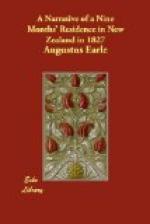I had heard a great deal respecting the splendid race of men I was going to visit, and the few specimens I had occasionally met with at Sydney so much pleased me, that I was extremely anxious to see a number of them together, to judge whether (as a nation) they were finer in their proportions than the English, or whether it was mere accident that brought some of their tallest and finest proportioned men before me.
I examined these savages, as they crowded round our decks, with the critical eye of an artist; they were generally taller and larger men than ourselves; those of middle height were broad-chested and muscular, and their limbs as sinewy as though they had been occupied all their lives in laborious employments. Their colour is lighter than that of the American Indian, their features small and regular, their hair is in a profusion of beautiful curls, whereas that of the Indian is straight and lank. The disposition of the New Zealander appears to be full of fun and gaiety, while the Indian is dull, shy, and suspicious.
I have known Indians in America from the north to the south—the miserable, idiotic Botecooda of Brazil, the fierce warrior of Canada, and the gentle and civilised Peruvian, yet in their features and complexions they are all much alike. I observed their statures altered with their different latitudes; the Chilians and the Canadians being nearly the same, in figure tall, thin, and active, their climate being nearly the same, although at the two extremes of America; while those living between the equinoxes are short, fat, and lazy. I am persuaded that these South Sea Islanders, though so nearly of the same complexion, still are not of the same race, laziness being the characteristic of the American Indian from north to south, while the New Zealanders are laborious in the extreme, as their astonishing and minute carvings prove. The moment the Indian tasted intoxicating spirits his valour left him, he became an idiot and a tool in the hands of the white man. Here they have the utmost aversion to every kind of “wine or strong drink,” and very often severely take us to task for indulging in such an extraordinary and debasing propensity, or, as they call it, “of making ourselves mad;” but both nations are equally fond of tobacco.
The first thing which struck me forcibly was, that each of these savages was armed with a good musket, and most of them had also a cartouch box buckled round their waists, filled with ball cartridges, and those who had fired their pieces from the canoes carefully cleaned the pans, covered the locks over with a piece of dry rag, and put them in a secure place in their canoes. Every person who has read Captain Cook’s account of the natives of New Zealand would be astonished at the change which has taken place since his time, when the firing of a single musket would have terrified a whole village.
As we sailed up the river very slowly, the throng of savages increased to such a degree that we could scarcely move, and, to add to our confusion, they gave us “a dance of welcome,” standing on one spot, and stamping so furiously that I really feared they would have stove in the decks, which our lady passengers were obliged to leave, as when the dance began each man proceeded to strip himself naked, a custom indispensable among themselves.




